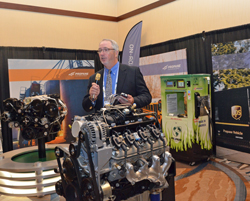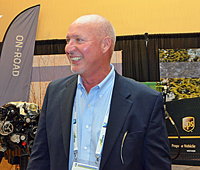2014 World LP Gas Forum Photo Album
 Earlier this year, the delivery giant UPS expanded commitment to propane by adding 1,000 propane delivery trucks and 50 fueling stations at UPS locations.
Earlier this year, the delivery giant UPS expanded commitment to propane by adding 1,000 propane delivery trucks and 50 fueling stations at UPS locations.
“It was the easiest alternative fuel they’ve ever transitioned into their fleet…the easiest installation of infrastructure of any alternative fuel,” said Michael Taylor, Autogas Business Director for the Propane Education and Research Council (PERC). The only complaint was that drivers said the new vehicles are “too quiet.”
 Powertrain Integration (PI) was the company that designed the propane autogas V8 packages that are being used in the new brown trucks and president Bob Pachla says UPS adopted the new propane technology very quickly. “Typically what they’ll do is put units into a fleet and test it and you’ll hear from them two or three years later,” said Pachla. “In this case, we put the fleet into production, 20 units, the fall of last year and they made the announcement this year to build a thousand UPS step vans.”
Powertrain Integration (PI) was the company that designed the propane autogas V8 packages that are being used in the new brown trucks and president Bob Pachla says UPS adopted the new propane technology very quickly. “Typically what they’ll do is put units into a fleet and test it and you’ll hear from them two or three years later,” said Pachla. “In this case, we put the fleet into production, 20 units, the fall of last year and they made the announcement this year to build a thousand UPS step vans.”
Taylor and Pachla discussed UPS and the propane powered engines at the recent World LP Gas Forum in Miami. Listen to them here and watch the video below: Propane Power for UPS










